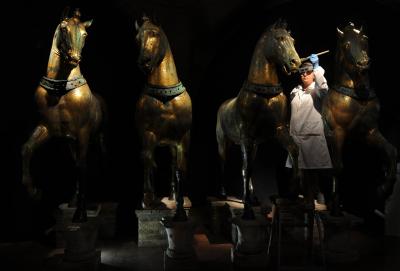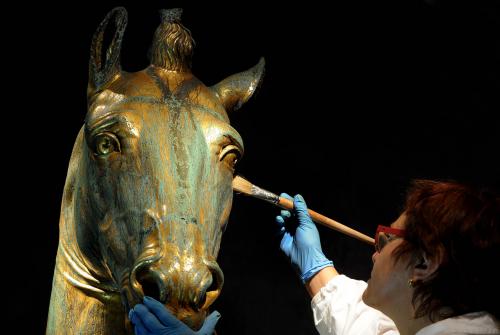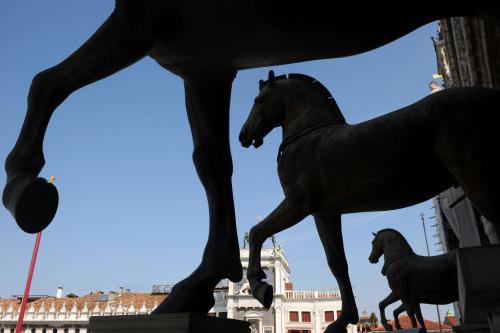The extraordinary horses of Saint Mark

VENICE-A masterpiece in man's history, the ancient four gilt-bronze horses of St Mark’s Basilica are the only ones to have survived after long and perilous journeys. With the aid of young French patrons, they have been renovated. This is the first time they can be admired in their full splendour.
Corinna Mattiello removes her mask, climbs down from the stepladder and tidies up her tools. The security tape will soon be removed and the public will once again be able to admire the four horses of St Mark’s Basilica from up close. Over three months, this Italian restorer has come every day to work under the brick vaults of the museum of the basilica. It is her who, for thirty years, has taken care of the ancient gilt-bronze quadriga, unique in the world, preserved inside the museum since the end of the 1970s.
This time she carried out a meticulous cleaning: “The alloy is composed of 96% copper. We must leave the surfaces oxidised, as the gilding on top is very fragile.” Patiently, Corinna Mattiello passes her brushes over the head, the neck, the sides, and the croup of these four life-size horses. She dusts them, identifies points of corrosion, and fixes them. Then, the restorer removes the old protective coating with acetone and applies it again. The horses of St Mark get back all of their glow.
Since each sculpture weighs almost 900kg, the restoration is carried out on the site. There is another reason too: “Each time the horses are moved, something bad happens. That’s why I hope they will stay here forever,” says Ettore Vio, the “Proto”, i.e. chief curator of St Mark’s basilica, the architect in charge of its maintenance. “They were hidden in the Palazzo Venezia in Rome during the First World War and in the monastery of Praglia near Padua during WWII. In 1981, on the day when we put them in the museum, we heard about the assassination of the Egyptian president Anouar el-Sadate…”
A coveted war treasure, notably by Napoleon Bonaparte
Over two millennia, the ancient quadriga has been on display outdoors: in Greece, in Constantinople, in Venice and even in Paris… Throughout their troubled history these four horses travelled thousands of kilometres: “They were supposedly produced in Greece for the Island of Rhodes or Chios. When the Roman emperor Constantine I founded Constantinople (4thcentury A.D.), he had the sumptuous equestrian sculpture transported to adorn his hippodrome,” explains Ettore Vio. The work in its entirety included a chariot drawn by horses and undoubtedly driven by Apollo.
In 1204, the crusaders and Venetians sack Constantinople and Doge Enrico Dandolo transports the horses to Venice on galleys. They are installed on top of the loggia above the porch of St Mark’s basilica, “to symbolise the triumph of the Church,” continues the “Proto.”
Five centuries later, during the first campaign in Italy, the gilt-bronze quadriga becomes again precious war booty: Napoleon Bonaparte’s troops bring it to Paris in 1797. The four horses are hoisted onto the triumphal arch of the Place du Carrousel between the Louvre and the Tuileries Garden in 1809. However, at the fall of the Emperor, the victorious Austrians give it back to the City of the Doges, which they have just annexed. In tribute to Napoleon’s Great Army, sculptor François Joseph Bosio made the Parisian copy which we know as: “Peace carried on a triumphal chariot (1828).”
A unifying project for young French patrons
The horses of St Mark are the last witnesses of a lost art. The majority of ancient metal sculptures were melted. Their origin has been much discussed. For some art historians and archaeologists the sculpture is Roman and dates back to the 4thcentury A.D. For others, it is Greek and dates from the 4thcentury B.C. During the first restoration, 1977-1981, fragments of molten earth were removed from inside the sculptures. The laboratory of Physics Applied to Archaeology (University of Bordeaux III) estimates that they date back to the 4th century B.C.
“Greek sculptor and worker in bronze Lysippos, a great artist of the Antiquity, is probably the author of the quadriga. The spirit which animates each of the horses, their eyes, their mouth, their look, the way in which they are placed one next to the other is characteristic of spiritual classicism, typical of ancient Greece,” explains Ettore Vio. For Jérôme Zieseniss, president of the French Committee for the preservation of Venice: “These horses are testimony to the age when the Greeks considered beauty as manifestation of truth, the search of the divine. Lysippos sculpted therefore an ideal horse.”
Over the last fifteen years, this Frenchman in love with Venice has persuaded patrons to finance the restoration of Venetian monuments and works of art. Together with François Pignol, he raised awareness of about a hundred of young alumni of the most prestigious French universities of this heritage and the need for patronage. “My friends have donated 100-200 euros each, 20.000 euros in total to contribute to the restoration of the horses of St Mark,” sums up François Pignol.
In the museum of the basilica, a numerous crowd of visitors streams past and lingers in front of the four horses positioned in pairs. Each has ears turned towards the other. According to Ettore Vio, “they seem to be talking to each other, telling each other wonderful things. I know a little girl who has a habit of speaking to the horse she mounts. And when she comes here to see the horses of St Mark, she speaks to them too.”
(Translation: Olga Majewska)




